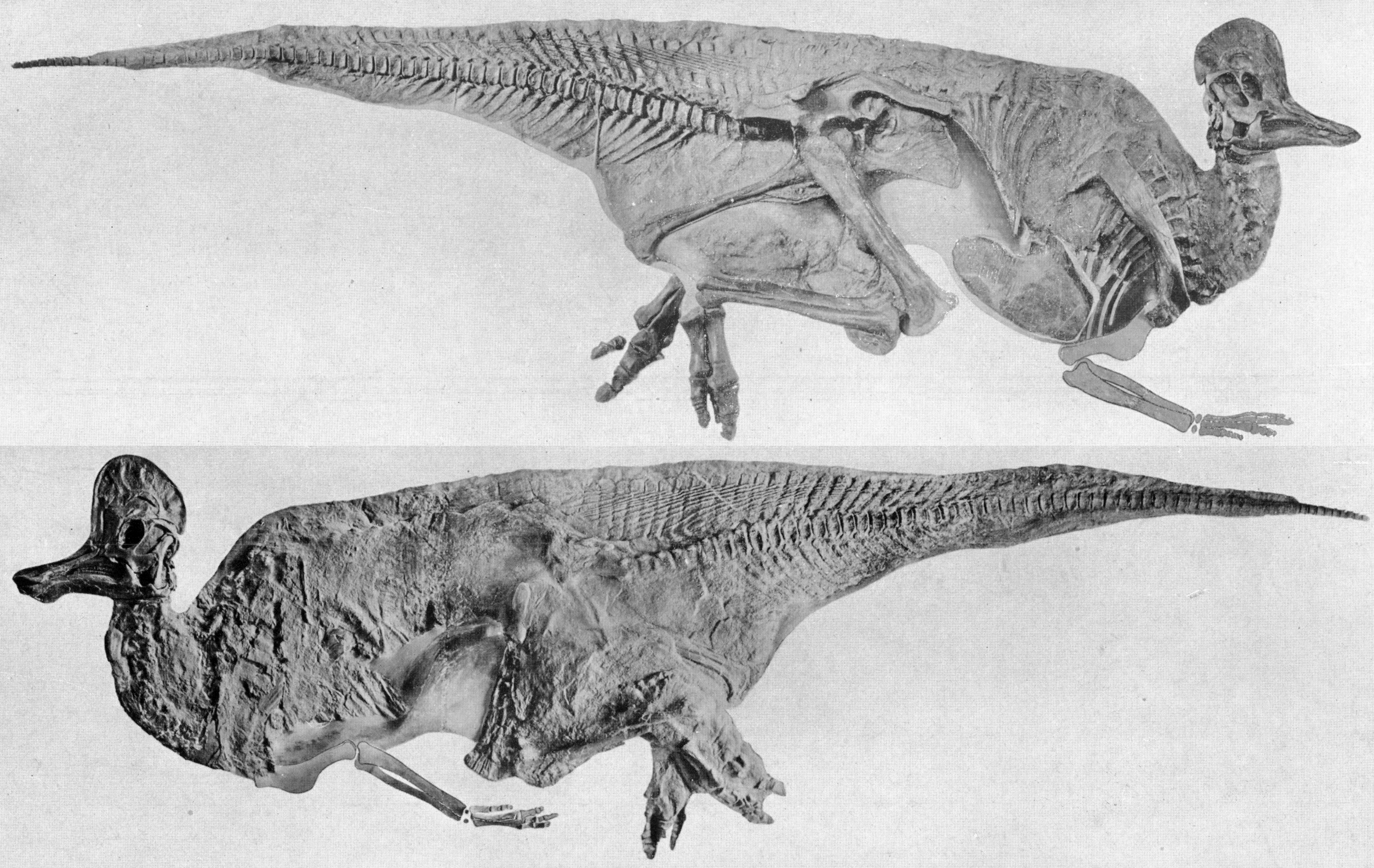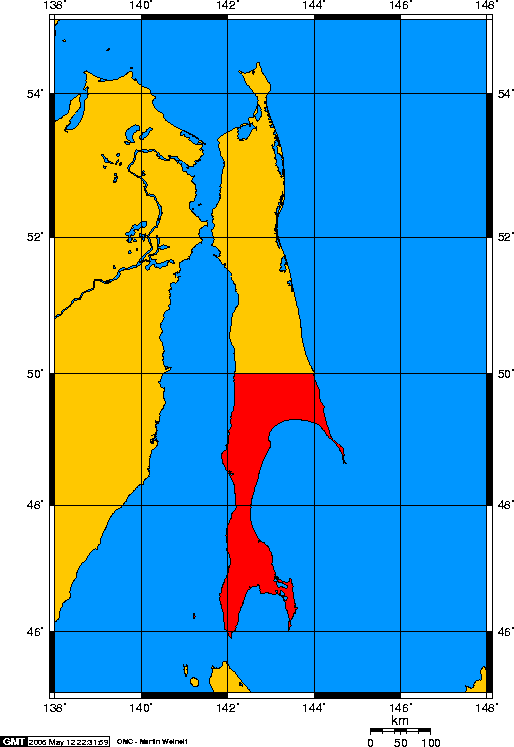|
Nipponosaurus
''Nipponosaurus'' (meaning "Japanese lizard") is a lambeosaurine hadrosaur from sediments of the Yezo Group, in Sinegorsk on the island of Sakhalin, which was part of Japan at the time of the species' classification. The type and only species is ''N. sachalinensis'', known only from a single juvenile specimen discovered in 1934 and named in 1936, by Takumi Nagao, with further material of the same individual found in 1937. Since then, the taxon has been largely ignored, and its validity has been doubted, with synonymy with other Asian hadrosaurs or status as a ''nomen dubium'' being suggested. Redescriptions from 2004 and 2017, however, have supported recognition as a distinct species. Dating the only specimen has been difficult, but based on associated mollusc taxa, the species likely lived sometime in the upper Santonian or lower Campanian, around 80 million years ago. History of study The holotype (UHR 6590, University of Hokkaidō Registration) was discovered in November ... [...More Info...] [...Related Items...] OR: [Wikipedia] [Google] [Baidu] |
Hypacrosaurus
''Hypacrosaurus'' (meaning "near the highest lizard" reek υπο-, ''hypo-'' = less + ακρος, ''akros'', high because it was almost but not quite as large as ''Tyrannosaurus'') was a genus of duckbill dinosaur similar in appearance to ''Corythosaurus''. Like ''Corythosaurus'', it had a tall, hollow rounded crest, although not as large and straight. It is known from the remains of two species that spanned 75 to 67 million years ago, in the Late Cretaceous of Alberta, Canada, and Montana, United States, and is the latest hollow-crested duckbill known from good remains in North America. It was an obscure genus until the discovery in the 1990s of nests, eggs, and hatchlings belonging to ''H. stebingeri''. Discovery and history The type remains of ''Hypacrosaurus'' were collected in 1910 by Barnum Brown for the American Museum of Natural History. The remains, a partial postcranial skeleton consisting of several vertebrae and a partial pelvis (AMNH 5204), came from along the R ... [...More Info...] [...Related Items...] OR: [Wikipedia] [Google] [Baidu] |
Corythosaurus
''Corythosaurus'' (; ) is a genus of hadrosaurid "duck-billed" dinosaur from the Upper Cretaceous Period (geology), Period, about 77–75.7 million years ago. It lived in what is now North America. Its name means "helmet lizard", derived from Ancient Greek, Greek κόρυς. It was named and described in 1914 by Barnum Brown. ''Corythosaurus'' is now thought to be a Lambeosaurinae, lambeosaurine, related to ''Nipponosaurus'', ''Velafrons'', ''Hypacrosaurus'', and ''Olorotitan''. ''Corythosaurus'' has an estimated length of , and has a skull, including the crest, that is tall. ''Corythosaurus'' is known from many complete specimens, including the nearly complete holotype found by Brown in 1911. The holotype skeleton is only missing the last section of the tail, and part of the forelimbs, but was preserved with impressions of polygonal scales. ''Corythosaurus'' is known from many skulls with tall crests. The crests resemble the crests of the cassowary and a Corinthian helmet. ... [...More Info...] [...Related Items...] OR: [Wikipedia] [Google] [Baidu] |
Yezo Group
The Yezo Group is a stratigraphic group in Hokkaido, Japan and Sakhalin, Russia which is primarily Late Cretaceous in age (Aptian to Earliest Paleocene). It is exposed as roughly north–south trending belt extending 1,500 kilometres through central Hokkaido from Urakawa to Cape Sōya and Sakhalin from the south coast to Alexandrovsk-Sakhalinsky District. It consists of marine forearc basin sediments, typically turbiditic and bioturbated mudstones and sandstones with subordinate conglomerate primarily deposited on the continental shelf and slope of the ancient Yezo subduction margin. It forms a continuous depositional sequence with the Sorachi Group, which overlies the Horokanai Ophiolite. The sequence gradually shallows upwards with the terminal Hakobuchi Formation representing a fluvial-inner shelf environment. Numerous fossils are known from the unit, mostly ammonites and bivalves, but also marine vertebrates such as mosasaurs, plesiosaurs and marine turtles. Dinosaur re ... [...More Info...] [...Related Items...] OR: [Wikipedia] [Google] [Baidu] |
1936 In Paleontology
Plants Ferns and fern allies Flowering plants Arthropods Insects Archosauromorphs Newly named dinosaurs Data courtesy of George Olshevsky's dinosaur genera list. Pterosaurs New taxa Synapsids Non-mammalian References {{DEFAULTSORT:1936 In Paleontology 1930s in paleontology Paleontology 6 ... [...More Info...] [...Related Items...] OR: [Wikipedia] [Google] [Baidu] |
Lambeosaurinae
Lambeosaurinae is a group of crested hadrosaurid dinosaurs. Classification Lambeosaurines have been traditionally split into the tribes or clades Parasaurolophini (''Parasaurolophus'', ''Charonosaurus'', others (?).) and Lambeosaurini (''Corythosaurus'', ''Hypacrosaurus'', ''Lambeosaurus'', others.). Corythosaurini (synonym of Lambeosaurini, see below) and Parasaurolophini as terms entered the formal literature in Evans and Reisz's 2007 redescription of ''Lambeosaurus magnicristatus''. Corythosaurini was defined as all taxa more closely related to ''Corythosaurus casuarius'' than to ''Parasaurolophus walkeri'', and Parasaurolophini as all those taxa closer to ''P. walkeri'' than to ''C. casuarius''. In this study, ''Charonosaurus'' and ''Parasaurolophus'' are parasaurolophins, and ''Corythosaurus'', ''Hypacrosaurus'', ''Lambeosaurus'', ''Nipponosaurus'', and ''Olorotitan'' are corythosaurins. However, later researchers pointed out that due to the rules of priority set forth b ... [...More Info...] [...Related Items...] OR: [Wikipedia] [Google] [Baidu] |
Soviet Union
The Soviet Union,. officially the Union of Soviet Socialist Republics. (USSR),. was a transcontinental country that spanned much of Eurasia from 1922 to 1991. A flagship communist state, it was nominally a federal union of fifteen national republics; in practice, both its government and its economy were highly centralized until its final years. It was a one-party state governed by the Communist Party of the Soviet Union, with the city of Moscow serving as its capital as well as that of its largest and most populous republic: the Russian SFSR. Other major cities included Leningrad (Russian SFSR), Kiev (Ukrainian SSR), Minsk ( Byelorussian SSR), Tashkent (Uzbek SSR), Alma-Ata (Kazakh SSR), and Novosibirsk (Russian SFSR). It was the largest country in the world, covering over and spanning eleven time zones. The country's roots lay in the October Revolution of 1917, when the Bolsheviks, under the leadership of Vladimir Lenin, overthrew the Russian Provisional Government ... [...More Info...] [...Related Items...] OR: [Wikipedia] [Google] [Baidu] |
Names Of Japan
The word ''Japan'' is an exonym, and is used (in one form or another) by many languages. The Japanese names for Japan are Nippon () and Nihon (). They are both written in Japanese using the kanji . During the third-century CE Three Kingdoms period, Japan was inhabited by the Yayoi people who lived in Kyushu up to the Kanto region. They were called ''Wa'' in Chinese, and the kanji for their name can be translated as "dwarf" or "submissive". Japanese scribes found fault with its offensive connotation, and officially changed the characters they used to spell the native name for Japan, ''Yamato'', replacing the ("dwarf") character for ''Wa'' with the homophone ("peaceful, harmonious"). ''Wa'' was often combined with ("great") to form the name , which is read as ''Yamato'' (see also Jukujikun for a discussion of this type of spelling where the kanji and pronunciations are not directly related). The earliest record of appears in the Chinese ''Old Book of Tang'', which notes the ... [...More Info...] [...Related Items...] OR: [Wikipedia] [Google] [Baidu] |
Japan
Japan ( ja, 日本, or , and formally , ''Nihonkoku'') is an island country in East Asia. It is situated in the northwest Pacific Ocean, and is bordered on the west by the Sea of Japan, while extending from the Sea of Okhotsk in the north toward the East China Sea, Philippine Sea, and Taiwan in the south. Japan is a part of the Ring of Fire, and spans Japanese archipelago, an archipelago of List of islands of Japan, 6852 islands covering ; the five main islands are Hokkaido, Honshu (the "mainland"), Shikoku, Kyushu, and Okinawa Island, Okinawa. Tokyo is the Capital of Japan, nation's capital and largest city, followed by Yokohama, Osaka, Nagoya, Sapporo, Fukuoka, Kobe, and Kyoto. Japan is the List of countries and dependencies by population, eleventh most populous country in the world, as well as one of the List of countries and dependencies by population density, most densely populated and Urbanization by country, urbanized. About three-fourths of Geography of Japan, the c ... [...More Info...] [...Related Items...] OR: [Wikipedia] [Google] [Baidu] |
Dinosaur
Dinosaurs are a diverse group of reptiles of the clade Dinosauria. They first appeared during the Triassic period, between 243 and 233.23 million years ago (mya), although the exact origin and timing of the evolution of dinosaurs is the subject of active research. They became the dominant terrestrial vertebrates after the Triassic–Jurassic extinction event 201.3 mya; their dominance continued throughout the Jurassic and Cretaceous periods. The fossil record shows that birds are feathered dinosaurs, having evolved from earlier theropods during the Late Jurassic epoch, and are the only dinosaur lineage known to have survived the Cretaceous–Paleogene extinction event approximately 66 mya. Dinosaurs can therefore be divided into avian dinosaurs—birds—and the extinct non-avian dinosaurs, which are all dinosaurs other than birds. Dinosaurs are varied from taxonomic, morphological and ecological standpoints. Birds, at over 10,700 living species, are among ... [...More Info...] [...Related Items...] OR: [Wikipedia] [Google] [Baidu] |
South Sakhalin
Karafuto Prefecture ( ja, 樺太庁, ''Karafuto-chō''; russian: Префектура Карафуто, Prefektura Karafuto), commonly known as South Sakhalin, was a prefecture of Japan located in Sakhalin from 1907 to 1949. Karafuto became territory of the Empire of Japan in 1905 after the Russo-Japanese War when the portion of Sakhalin south of 50°N was ceded from the Russian Empire in the Treaty of Portsmouth. Karafuto was established in 1907 as an external territory until being upgraded to an " Inner Land" of the Japanese metropole in 1943. Ōtomari (Korsakov) was the capital of Karafuto from 1905 to 1908 and Toyohara (Yuzhno-Sakhalinsk) from 1908 to August 1945 when the Japanese administration ceased to function in the invasion of South Sakhalin by the Soviet Union after the surrender of Japan in World War II. Karafuto Prefecture was de facto replaced with Sakhalin Oblast, although it continued to exist de jure under Japanese law until it was formally abolished as a lega ... [...More Info...] [...Related Items...] OR: [Wikipedia] [Google] [Baidu] |
Trachodon
''Trachodon'' (meaning "rough tooth") is a dubious genus of hadrosaurid dinosaur based on teeth from the Campanian-age Upper Cretaceous Judith River Formation of Montana, U.S.Leidy, J. (1856). "Notice of remains of extinct reptiles and fishes, discovered by F. V. Hayden in the Bad Lands of the Judith River, Nebraska Territories." ''Proceedings of the Academy of Natural Science Philadelphia'', 8(25 March): 72–73. It is a historically important genus with a convoluted taxonomy that has been all but abandoned by modern dinosaur paleontologists.Creisler, B.S. (2007). Deciphering duckbills. in: K. Carpenter (ed.), ''Horns and Beaks: Ceratopsian and Ornithopod Dinosaurs''. Indiana University Press: Bloomington and Indianapolis, 185–210. Despite being used for decades as the iconic duckbill dinosaur, the material it is based on is composed of teeth from both duckbills and ceratopsids (their teeth have a distinctive double rootHatcher, J.B., Marsh, O.C. and Lull, R.S. (1907). ''Th ... [...More Info...] [...Related Items...] OR: [Wikipedia] [Google] [Baidu] |
Specific Name (zoology)
In zoological nomenclature, the specific name (also specific epithet or species epithet) is the second part (the second name) within the scientific name of a species (a binomen). The first part of the name of a species is the name of the genus or the generic name. The rules and regulations governing the giving of a new species name are explained in the article species description. For example, the scientific name for humans is ''Homo sapiens'', which is the species name, consisting of two names: ''Homo'' is the " generic name" (the name of the genus) and ''sapiens'' is the "specific name". Historically, ''specific name'' referred to the combination of what are now called the generic and specific names. Carl Linnaeus, who formalized binomial nomenclature, made explicit distinctions between specific, generic, and trivial names. The generic name was that of the genus, the first in the binomial, the trivial name was the second name in the binomial, and the specific the proper term for ... [...More Info...] [...Related Items...] OR: [Wikipedia] [Google] [Baidu] |








